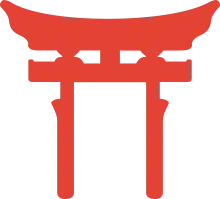Kannushi
A Kannushi (神主, "Divine Master (of ceremonies)", originally pronounced Kamunushi), also called shinshoku (神職, meaning "god's employee"), is a person responsible for the maintenance of a Shinto shrine (神社, jinja) as well as for leading worship of a given kami.[1] The characters for kannushi are sometimes also read as jinshu with the same meaning.
| Part of a series on |
| Shinto |
|---|
 |
History
Originally, the kannushi were intermediaries between kami and people and could transmit their will to common humans.[2] A kannushi was a man capable of miracles or a holy man who, because of his practice of purificatory rites, was able to work as a medium for a kami. Later the term evolved to being synonymous with shinshoku - a man who works at a shrine and holds religious ceremonies there.[1][3]
In ancient times, because of the overlap of political and religious power within a clan, it was the head of the clan who led the clansmen during religious functions, or else it could be another official.[3] Later, the role evolved into a separate and more specialized form. The term appears in both the Kojiki (680 AD) and Nihon Shoki (720 AD),[3] where the Empress Jingū and Emperor Sujin respectively become kannushi.[2]
Description
Within the same shrine, such as at Ise Jingū or Ōmiwa Shrine, there can be different types of kannushi at the same time; these may be called, for example, Ō-kannushi (大神主), Sō-kannushi (総神主), or Gon-kannushi (権神主).[2][3] Kannushi are assisted in their religious or clerical work by women called miko.
Kannushi can marry, and their children usually inherit their position.[4] Although this hereditary status is no longer legally granted, it continues in practice.[5]
Vestments and ritual objects
The clothes kannushi wear, such as the jōe, the eboshi and kariginu, do not have any special religious significance, but are simply official garments previously used by the Imperial court.[4] This detail reveals the close connection between kami worship and the figure of the Emperor.[4] Other implements used by kannushi include a baton called shaku and a wand decorated with white paper streamers (shide) called ōnusa.

 A kannushi in full dress, Katori Shrine
A kannushi in full dress, Katori Shrine A kannushi wearing a kariginu and an eboshi hat
A kannushi wearing a kariginu and an eboshi hat
Education
To become a kannushi, a novice must study at a university approved by the Association of Shinto Shrines (神社本庁, Jinja Honchō), typically Tokyo's Kokugakuin University or Ise's Kogakkan University, or pass an exam that will certify his qualification.[5] Women can also become kannushi, and widows can succeed their husbands in their job.[5]
References
-
- Kannushi (in Japanese), Iwanami Kōjien (広辞苑) Japanese dictionary, 6th Edition (2008), DVD version
- Nishimuta, Takao (2007-03-28). "Kannushi". Encyclopedia of Shinto. Kokugakuin. Retrieved 2009-10-16.
- Moriyasu, Jin. "Kannushi". Nihon Hyakka Zensho (in Japanese). Shogakukan. Archived from the original on 2012-09-14. Retrieved 2009-10-16.
- Nishimura, Hajime (1998). A Comparative History of Ideas. Motilal Banarsidass. ISBN 978-81-208-1004-4.
- "Shinshoku". Encyclopædia Britannica Online. Retrieved 2009-10-16.